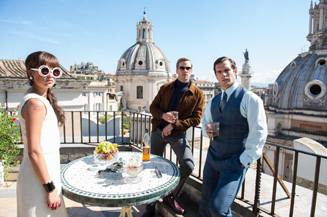|
|
Movie Review: The Man from U.N.C.L.E.By Ben GruchowAugust 17, 2015
The final set piece, though, involving a Jeep, a dune buggy, and a motorcycle, is godawful - hectically shot with none of the rest of the movie’s skill or care, stuffed to the gills with CGI that is thoroughly competent without ever really being convincing, and over-edited to within an inch of its life. (I would give quite a lot for a moratorium on artificially created crash-zooms: those moments where we get a sloppy pan or tilt into an shot, and then we quickly zoom in or out of a particular element of the frame, as if we’re watching a gritty documentary rather than a multimillion-dollar feature film. In the most galling of these, the frame is partially or entirely CGI; this means that the shot was professionally arranged to look unprofessional. This coy faux-documentary tactic has pervaded films where it’s irrelevant or detrimental to the story - but the crash-zoom technique is in a category all its own, and there’s no real reason for it to exist here except to create work for the special effects guys.) Anyway, this sequence goes on forever; when it does grind to a halt, we’re grateful for all the wrong reasons. We’ve been to this cinematic well many times before, and we need some sort of wrinkle or take on the material, and nothing here is really that refreshing or new. I tend not to truck with the idea that an adaptation’s quality should be graded on a curve relative to how loyal it is to its source material; this means that The Man From U.N.C.L.E. lives or dies on how it stands out as a thing in and of itself. There’s the good movie, and there’s the unobjectionable one; this movie illustrates very clearly the difference between the two. The good one came out a couple of weeks ago.
|

|
|
|

|
Friday, November 1, 2024
© 2024 Box Office Prophets, a division of One Of Us, Inc.


